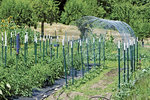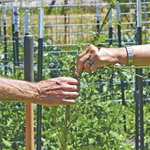

Before I started my garden, I was constantly daydreaming about starting my garden. I don’t know what sparked this mild obsession, but I assume one Pinterest post led to another and after a while the algorithm plastered my feed with enough homesteading content that my psyche gladly adopted it as my destiny.
I sat with this dream for years while living in a studio apartment in Tacoma and would secretly judge homeowners with a sunny yard for not utilizing their space “properly.” Ironically, I was also constantly driving by the community gardens in various neighborhoods around Tacoma and would acknowledge them by thinking something along the lines of “what a great idea,” but never considered them as something I could or would participate in. Between not having any gardening experience and not wanting to pay for a plot where that lack of experience would be showcased, these spaces existed in abstraction.
Cut to three years ago. During the height of pandemic panic, I moved back home on the KP and finally had the chance to put seed to soil. I was certain I would be able to grow enough food for my family of five if the lockdown lasted indefinitely. I really built it up in my head that I was going to be this garden savant able to tap into ancestral wisdom of subsistence traditions and the endeavor would be nothing short of a spectacular triumph resulting in astounding and abundant success.
But despite all the arrogant soul-searching and books I ended up ordering, my harvest was comically bad considering the situation. Things grew, but nothing turned out great. I made some rookie mistakes that could have easily been hashed out on a much smaller scale had I started my gardening journey a lot earlier during a less intense time.
Unbeknownst to me up until recently, the Pierce County Conservation District has a great urban agriculture program called Harvest Pierce County that aims to build food security networks through education and volunteer efforts. They currently sponsor 80 different food projects, including the four gardens in my old neighborhood and three in Gig Harbor proper.
Joining a community garden when I was living in that apartment would have been a great way to develop my green thumb, but more importantly a great way to make connections with people who had similar goals and the wisdom I desired.
And even now, though I’ve been primarily working in semi-isolation to develop my skills in my own garden the past couple years, becoming more involved with community gardens and working to create these collaborative spaces is more appealing than ever.
A few community gardens have been started on the KP, including at the Longbranch Improvement Club, Herron Island, Lakebay Community Church and at Food Backpacks 4 Kids in Key Center. But given that the peninsula is a large landmass with a decent-sized population, establishing more neighborhood spaces that can coordinate efforts may be the key to building a foundation for an ongoing community tradition.
On the Harvest Pierce County webpage there are resources for groups that want to start their own gardens, such as outlines for the garden management structure. They also offer online educational workshops throughout the year. Upcoming lessons include composting, seed saving and growing fruit trees in the PNW.
If you’re interested in starting a home garden but are unsure about where to begin the process, the best way to go about it is just to be curious. Start with asking “What do I like to eat?” and from there search for where to buy those seeds and go down the rabbit hole of varieties you would have never guessed existed. I’m talking pink celery, red celery, purple bok choy, strawberry spinach and black nebula carrots, just to name a few. After that all you need is some quality soil, water and sun.
Home gardens don’t have to be massive to be highly productive. There are various methods that can easily be worked into your schedule and skill set. If your porch or deck gets a good amount of sun, consider keeping a few containers of herbs and salad greens among your flower pots. Tomatoes, peppers, beans and cucumbers are also great for container growing.
But, alas, life is busy, and if you don’t have the time for an excessive amount of annual crops, planting perennial crops among your existing landscape is a great way to ensure there will be something to harvest at some point during the growing season. Herbs like mint, thyme, oregano, rosemary, sage, Roman chamomile, as well as fruiting trees, berry bushes, artichokes, asparagus, strawberries and rhubarb can all be mixed into established landscapes to add an extra element of interest. It all makes a difference.
UNDERWRITTEN BY THE FUND FOR NONPROFIT NEWS (NEWSMATCH) AT THE MIAMI FOUNDATION, THE ANGEL GUILD, ADVERTISERS, DONORS AND PEOPLE WHO SUPPORT INDEPENDENT, NONPROFIT LOCAL NEWS